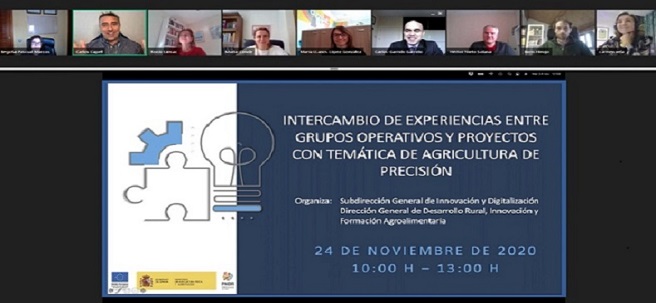
04 de December de 2020
December 4, 2020. The Ministry of Agriculture, Fisheries, and Food (MAPA) has organized a day of experience sharing between operational groups and innovative projects on precision agriculture. Precision agriculture is a management strategy that collects, processes, and analyzes data and combines it with other information to improve the efficiency of agricultural production. This requires a set of technologies based on sensors and both satellite and aerial images to capture crop variations.
- The MAPA has organized a meeting between Operational Groups and Innovative Projects on precision agriculture.
- During the meeting, participants were able to exchange knowledge about the use of new technologies in agriculture, such as remote sensing, artificial intelligence, Big Data, drones, and robotics.
The information collected is used to more accurately determine planting density, estimate the appropriate amount of fertilizer or other necessary inputs (seeds, pesticides, etc.), and more accurately predict crop yield and production.
- Participants: “ AGROTIG ”: development of a web-based mapping server for monitoring cereal crops by remote sensing” and “ APOLLO ”: development of a commercial platform for agricultural advisory services based on free and open access Earth observation data.
- Papers and Conclusions: Among the challenges posed, it was highlighted that precision agriculture requires low-cost services and technologies that are easy to implement for technicians and farmers. The importance of promoting R&D&I projects that consider the co-creation of products and services with users was emphasized.
- Participants: “ RECOLECTA ”: prediction of the optimal harvesting time through comprehensive thermal management of crops” and “ BIHORTAFLOR ”: applying artificial intelligence and big data solutions to improve the economic and environmental efficiency of agricultural holdings.
- Papers and conclusions: The importance of giving a second life to data, both data collected by producers and data obtained through new technologies (sensors, satellites, and meteorology), to solve specific problems (e.g., determining the optimal time to harvest with maximum quality in advance). It was also highlighted how the incorporation of new technologies into agriculture contributes to improving water use and consumption, as well as farm profitability.
- Participants: “Integration of multispectral and agroclimatic data obtained through drones and satellite images in vineyard management for decision-making in viticulture” and “ SMART AKIS: GIS ”, precision agriculture, and agricultural automation and robotics.
- Papers and Conclusions: This section highlighted the importance of multispectral image data, which, combined with climatic, soil, and agronomic variables collected by drones, allows for improved crop management and monitoring. It was also emphasized that it is important to demonstrate the benefits of smart agriculture, innovate business models, ensure broadband connectivity in rural areas, develop user-friendly solutions and promote interoperability standards, create a transparent framework for the use of generated data, introduce smart agriculture into education and training of technicians, and strengthen the role of impartial (non-commercial) advisors in digitalization.









